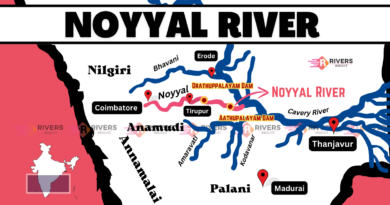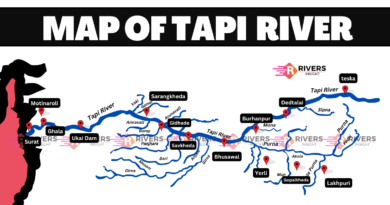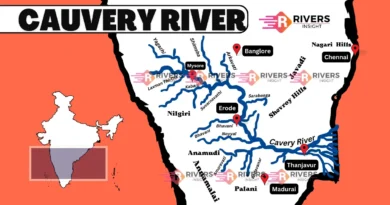Major Rivers of India: Map, List & Quick Outline
India is home to a vast network of Himalayan and Peninsular rivers, many of which rank among the most significant river systems in the world. For instance, rivers like the Ganga and Brahmaputra are important due to their length and water volume and play a crucial role in shaping India’s history.
This article provides a comprehensive overview of Indian River Systems, covering the Himalayan and Peninsular rivers. We’ll discuss major rivers like the Ganga, Brahmaputra, Godavari, and Krishna, and classify them based on their flow direction. You’ll also find a list of major rivers of India, with key details on their origin and significance, along with a section on rivers by state.
What is a River System?
A river system refers to a network of interconnected rivers, streams, and their tributaries that collectively drain water from the land to a larger body of water, like an ocean or sea. This system includes:
- Main River: The principal watercourse.
- Tributaries: Smaller streams or rivers that feed into the main river.
- Drainage Basin: The area of land where water collects and flows into the river system.
Indian River Systems Overview
India’s river system is among the most extensive and diverse in the world, playing a significant role in the country’s agriculture, culture, and ecology. The rivers of India are classified into two primary categories based on their origin and geographical flow: Himalayan Rivers and Peninsular Rivers.
Classification of Indian Rivers
Himalayan Rivers
The Himalayan Rivers are snow-fed rivers that originate from the glaciers of the majestic Himalayan mountain range. These rivers are known for their perennial flow, meaning they have water throughout the year, even in dry seasons.
Key Himalayan Rivers:
- Ganga
- Yamuna
- Brahmaputra
- Indus
- Chenab
- Jhelum
- Sutlej
Peninsular Rivers
The Peninsular Rivers are located in the southern part of India and have different characteristics compared to the Himalayan rivers. These rivers are generally rain-fed, which means their flow is seasonal and can vary from year to year. Further, Peninsular rivers can be classified into East-flowing and West-flowing rivers.
East-Flowing Rivers
These rivers flow towards the Bay of Bengal and form some of the most fertile deltas in India, supporting extensive agriculture. These rivers are longer and cover wider areas.
Key East-Flowing Rivers:
- Godavari (the second-longest river in India)
- Krishna
- Mahanadi
- Kaveri (also called the Dakshina Ganga)
West-Flowing Rivers
Unlike their eastern counterparts, West-Flowing Rivers are relatively shorter and flow towards the Arabian Sea. Despite their shorter length, these rivers play an important role in the water supply and hydropower generation in western India.
Key West-Flowing Rivers:
- Narmada
- Tapi (Tapti)
- Mahi
Map of Indian Rivers (Downloadable PDF)

List of Major Rivers of India
1. Ganga River
- Origin: Gangotri Glacier, Uttarakhand (Bhagirathi River).
- Length: 2,525 km, longest in India.
- Major Tributaries:
- Left-bank: Ramganga, Gomti, Ghaghara, Gandak, Kosi, Mahananda.
- Right-bank: Yamuna, Son, Tamsa.
- Major Cities: Varanasi, Prayagraj, Kolkata.
- Divides at Farakka: Splits into the Bhagirathi-Hooghly (India) and Padma River (Bangladesh).
- Learn More: Ganga River System of India
2. Brahmaputra River
- Origin: Chemayungdung Glacier, Tibet (Yarlung Tsangpo).
- Length: 2,900 km (916 km in India).
- Major Tributaries:
- Left-bank: Lohit, Dibang, Burhi Dihing, Dhansari.
- Right-bank: Teesta, Manas, Subansiri, Sankosh, Kameng.
- Major Cities: Guwahati, Jorhat, Dibrugarh.
- Explore more: Brahmaputra River System with Map
3. Indus River
- Origin: Tibetan Plateau, near Lake Mansarovar.
- Length: 3,180 km (1,114 km in India).
- Major Cities: Leh (India).
- Significance: Historically important for the Indus Valley Civilization.
- Political: Governed by the Indus Waters Treaty between India and Pakistan.
- Indus River System: Sindhu Nadi
4. Yamuna River
- Origin: Yamunotri Glacier, Uttarakhand.
- Length: 1,376 km.
- Major Tributaries:
- Left-bank: Hindon, Tons.
- Right-bank: Chambal, Betwa, Sindh, Ken.
- Major Cities: Delhi, Agra, Prayagraj.
- Learn More: Yamuna River System: Detailed Map with Tributaries
5. Godavari River
- Origin: Brahmagiri Hills, Maharashtra.
- Length: 1,465 km, the second-longest river in India.
- Major Tributaries:
- Left-bank: Pranahita, Indravati, Sabari.
- Right-bank: Manjira, Purna, Pravara.
- Major Cities: Nashik, Rajahmundry.
- Significance: Known as the Dakshin Ganga, holds religious importance in places like Nashik.
- Learn more: Godavari River
6. Krishna River
- Origin: Mahabaleshwar, Maharashtra.
- Length: 1,400 km.
- Major Tributaries:
- Left-bank: Bhima, Musi, Munneru.
- Right-bank: Koyna, Tungabhadra, Panchganga.
- Major Cities: Vijayawada, Kurnool.
- Explore: Krishna River System: Overview with Map and Tributaries
7. Narmada River
- Origin: Amarkantak Plateau, Madhya Pradesh.
- Length: 1,312 km.
- Major Cities: Jabalpur, Bharuch.
- Read more: Narmada River System
8. Tapi River
- Origin: Satpura Range, Madhya Pradesh.
- Length: 724 km.
- Major Cities: Surat, Jalgaon.
- More: Tapi River: Map and Course with Tributaries
9. Mahanadi River
- Origin: Sihawa Hills, Chhattisgarh.
- Length: 851 km.
- Major Cities: Raipur, Cuttack.
- Explore more: Mahanadi River System
10. Cauvery River
- Origin: Brahmagiri Hills, Karnataka.
- Length: 805 km.
- Major Tributaries:
- Left-bank: Harangi, Hemavati, Shimsha.
- Right-bank: Kabini, Bhavani, Noyyal.
- Major Cities: Mysuru, Srirangapatna, Tiruchirappalli.
- Learn more: Cauvery River System
11. Chambal River
- Origin: Janapav Hills, Madhya Pradesh.
- Length: 1,024 km.
- Major Cities: Kota, Dholpur.
- Significance: Least polluted, home to endangered species like the gharial and Gangetic dolphin.
- Economic: Vital for irrigation in dry areas of Rajasthan and Madhya Pradesh.
- Read More: Chambal River of India
12. Son River
- Origin: Amarkantak Plateau, Madhya Pradesh.
- Length: 784 km.
- Major Cities: Patna (confluence with the Ganga).
- Significance: Flows northward to join the Ganga.
- Explore: Son River: Map and Origin with States
Rivers by Indian States
| S. No. | State | Rivers |
|---|---|---|
| 1 | Andhra Pradesh | Godavari, Musi |
| 2 | Bihar | Ganga |
| 3 | Delhi | Yamuna |
| 4 | Goa | Mandovi, Zuari |
| 5 | Gujarat | Sabarmati, Mahi, Narmada, Tapi |
| 6 | Haryana | Yamuna |
| 7 | Jharkhand | Damodar, Ganga, Subarnarekha |
| 8 | Karnataka | Bhadra, Tungabhadra, Cauvery, Tunga, Pennar |
| 9 | Kerala | Pamba, Periyar, Bharathapuzha |
| 10 | Madhya Pradesh | Betwa, Tapti, Wainganga, Khan, Narmada, Kshipra, Beehar, Chambal, Mandakini |
| 11 | Maharashtra | Krishna, Godavari, Tapi, Panchganga |
| 12 | Nagaland | Diphu, Dhansiri |
| 13 | Odisha | Brahmani, Mahanadi |
| 14 | Punjab | Satluj, Beas, Ravi |
| 15 | Rajasthan | Chambal |
| 16 | Sikkim | Rani Chu |
| 17 | Tamil Nadu | Cauvery, Adyar, Cooum, Vennar, Vaigai, Tambarani |
| 18 | Uttar Pradesh | Yamuna, Ganga, Gomti |
| 19 | Uttarakhand | Ganga |
| 20 | West Bengal | Ganga, Damodar, Mahananda |
Longest Rivers of India
| S. No. | River | Length in India (km) | Total Length (km) |
|---|---|---|---|
| 1 | Ganga | 2,525 | 2,525 |
| 2 | Godavari | 1,464 | 1,465 |
| 3 | Krishna | 1,400 | 1,400 |
| 4 | Yamuna | 1,376 | 1,376 |
| 5 | Narmada | 1,312 | 1,312 |
| 6 | Indus | 1,114 | 3,180 |
| 7 | Brahmaputra | 916 | 2,900 |
| 8 | Mahanadi | 890 | 890 |
| 9 | Kaveri | 800 | 800 |
| 10 | Tapi (Tapti) | 724 | 724 |
Conclusion
In conclusion, India’s rivers are essential for its ecological balance, agriculture, and economy. From the Himalayan to the Peninsular rivers, they support millions of lives and drive development. Major dams and river projects play a crucial role in water management and regional growth.
However, challenges like pollution and climate change demand sustainable conservation efforts. Protecting these vital water resources is key to ensuring a prosperous and sustainable future for India and its people.





Information is good but showing major rivers and tributaries same colour format (like blue) it takes time to identify .my suggestion is major rivers and tributaries show a different colour format and font
Thanks for the suggestion! We’ll keep this in mind for future updates.
Great work, Sir .Very useful Content and the map looks clear and concise.
Thanks Dear!